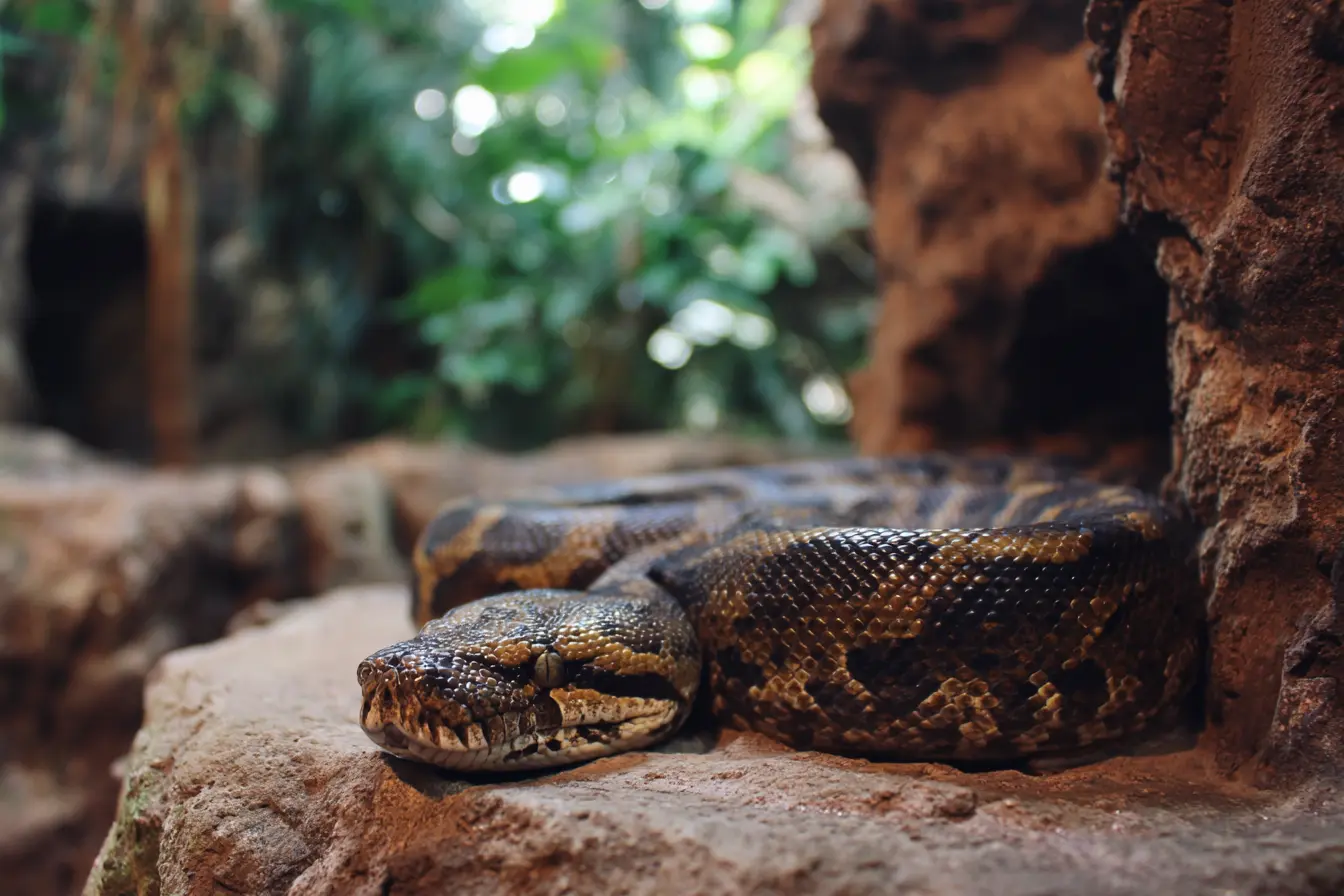
Bredl’s Python: The Gentle Giant of the Carpet Python Family
The Bredl’s python (Morelia bredli), also known as the Centralian carpet python, is a striking and intelligent snake species native to the arid interior of Australia. Renowned for its calm temperament, impressive size, and vivid patterning, this python has become a firm favourite among experienced reptile keepers in the UK.
In this post, we’ll explore everything you need to know about keeping a Bredl’s python, including habitat setup, feeding, behaviour, and health care, to ensure your snake thrives in captivity.
Origins and Natural Habitat
Bredl’s pythons are native to the MacDonnell Ranges of central Australia, an area defined by rocky outcrops, sparse woodland, and semi-arid scrubland. Temperatures here fluctuate dramatically between day and night, with hot days and cool evenings.
In the wild, these pythons are semi-arboreal, often found basking on rocks or coiled in trees during the day, and hunting small mammals and birds at night. Their natural environment provides crucial insight into how to replicate the right conditions in captivity.
Appearance and Temperament
Physical Traits
- Size: Adults typically reach 2–2.5 metres in length, though exceptional individuals may exceed 3 metres
- Colouration: Rich reddish-brown to orange tones overlaid with lighter cream or grey banding
- Build: Muscular yet elegant, with a distinctive broad head and slender neck
Behaviour and Temperament
Bredl’s pythons are known for their docile and intelligent nature. When well-socialised, they are typically calm and tolerate gentle handling. They are active and curious, especially in the evening, often exploring their enclosure.
This species is generally considered one of the best large pythons for keepers who have some experience with snakes.
Housing Requirements
Creating a habitat that mimics their natural environment is key to keeping your Bredl’s python healthy and content.
Enclosure Size
- Juveniles: Start in a 90 cm x 45 cm x 45 cm vivarium
- Adults: Require at least 180 cm x 90 cm x 90 cm, though larger is always better
- Material: Wooden vivariums are ideal for heat retention in UK climates
Heating and Temperature Gradient
- Basking area: 32–34°C
- Cool end: 26–28°C during the day
- Night-time drop: Around 22°C to mimic natural temperature fluctuations
Use a ceramic heat emitter or deep-heat projector controlled by a reliable thermostat. Always monitor temperatures with digital thermometers at both ends of the enclosure.
Lighting and UVB
While Bredl’s pythons are primarily nocturnal, UVB lighting (2–7%) can benefit their overall health, supporting natural vitamin D3 synthesis and improved activity patterns. Provide a 12-hour light cycle to replicate day and night rhythms.
Humidity
Maintain humidity levels around 40–60%, with occasional increases during shedding. A large water bowl for soaking and regular misting will help achieve this.
Furnishings and Substrate
- Substrate: Aspen, cypress mulch, or a mix of soil and sand works well
- Decor: Branches, ledges, and hides to encourage climbing and security
- Hides: Provide at least two - one on the warm side and one on the cool side
These snakes are semi-arboreal and appreciate vertical climbing opportunities and strong branches that can support their weight.
Diet and Feeding
Bredl’s pythons are carnivorous constrictors, feeding primarily on mammals and birds in the wild.
Feeding Schedule
- Juveniles: Every 7–10 days
- Adults: Every 2–3 weeks
Food Items
- Appropriately sized frozen-thawed rodents or chicks
- Prey size should be roughly equivalent to the snake’s girth at its widest point
Feeding Tips
- Offer food using feeding tongs to avoid accidental bites
- Feed in the enclosure to reduce handling stress
- Ensure the prey is fully thawed and warmed to room temperature
Avoid overfeeding; these snakes are prone to obesity in captivity.
Handling and Interaction
Bredl’s pythons are widely appreciated for their calm and tolerant behaviour. With consistent, gentle handling, they usually become confident and curious companions.
Handling Guidelines
- Always wash hands before and after handling
- Support the snake’s full body. Never grab or restrain the head
- Limit handling after feeding or shedding
- Start with short sessions and gradually increase duration
These snakes can become surprisingly interactive, often recognising regular handling routines.
Common Health Concerns
Respiratory Infections
Caused by low temperatures or excessive humidity. Symptoms include wheezing, open-mouth breathing, or nasal bubbles. Ensure proper ventilation and temperature control.
Mites and Parasites
External mites can cause irritation and lethargy. Use reptile-safe treatments and maintain good hygiene.
Retained Shed
Low humidity may cause incomplete shedding. Provide rough surfaces and increase humidity during shed cycles.
Mouth Rot (Stomatitis)
A bacterial infection presenting as redness or pus around the mouth. Early veterinary care is essential.
Regular health checks and maintaining optimal husbandry conditions are the best preventive measures.
Breeding
Bredl’s pythons breed relatively well in captivity. Breeding pairs should only be attempted by experienced keepers.
- Brumation period: A slight drop in temperature (to around 24°C) during winter can stimulate breeding behaviour
- Clutch size: 10–25 eggs
- Incubation: 60–70 days at 31–32°C Females are generally good mothers and may coil around their eggs for protection.
Lifespan and Long-Term Care
With proper care, a Bredl’s python can live for 25–30 years or more in captivity. This is a long-term commitment that requires space, time, and dedication.
Regular cleaning, health checks, and enrichment activities (such as rearranging decor or offering new climbing structures) will keep your python stimulated and healthy.
Conclusion
The Bredl’s python is an exceptional species for those seeking a large but manageable and friendly python. Its impressive size, gentle temperament, and striking appearance make it a standout among carpet pythons.
By providing a spacious enclosure, correct heating and lighting, and a balanced feeding schedule, you can ensure this remarkable reptile thrives for decades.
Whether you’re expanding your reptile collection or taking your first step into keeping a large python, the Bredl’s python is a truly rewarding choice.
Related Vets
Vets near you
Speciality vets
- Aquatics vet specialists
- Birds vet specialists
- Camelids vet specialists
- Cats vet specialists
- Cattle vet specialists
- Deer vet specialists
- Dogs vet specialists
- Equines vet specialists
- Exotic vet specialists
- Goats vet specialists
- Pigs vet specialists
- Poultry vet specialists
- Sheep vet specialists
- Small Mammals vet specialists
- Wild vet specialists










